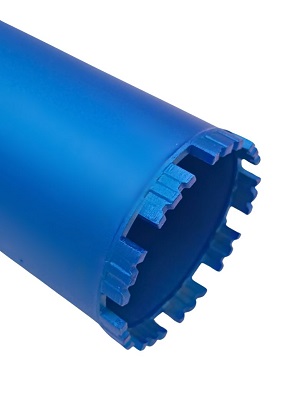Diamond Core Drill Bits – What They Are and the Types Explained
Wysłane przez
wrz 5, 2025
0Komentarze
A diamond core drill bit (core bit) is a steel tube with a diamond cutting rim. Instead of crushing material like a twist drill, it cuts a ring and leaves a core, which makes holes faster, cleaner and precisely sized.
Construction & how it works
- Barrel – steel tube of a given diameter and length (e.g., 35–450 mm).
- Cutting rim – diamond: sintered, segmented for concrete/RC, or electroplated (vacuum-brazed) for porcelain/stone.
- Mount – M14 (angle grinders), 1/2" BSP or 1 1/4" UNC (core rigs). Adapters are available.
- Cooling – wet (best life) or dry (short holes, mobile work).
Types by material
- Concrete / reinforced concrete – use sintered, segmented cores. Harder bond for abrasive materials; softer bond for rebar so diamonds expose faster and avoid glazing.
- Porcelain, ceramic, natural stone – electroplated (vacuum-brazed) or thin-wall segmented bits. They start cleanly with minimal chipping.
- Asphalt / very abrasive media – wider gullets and a softer bond to clear swarf efficiently.
Types by tool
- Core rigs – 1/2" BSP or 1 1/4" UNC, mostly wet drilling, larger diameters (68–300+ mm) for pass-throughs and sleeves.
- Angle grinder (M14) – quick holes in porcelain/stone (6–35 mm) and light concrete duties (with cooling breaks).
- Drill/driver – no hammer; with adapters you can run M14/BSP cores, but control RPM and maintain alignment.
Diameters & lengths
Small: 6–12 mm (fixings, anchors). Installation sizes: 32–132 mm (boxes, pipes). Large: 160–300+ mm (service penetrations). Common working lengths: 35–60 mm (tiles) and 300–450 mm (concrete).
Wet or dry?
- Wet – superior cooling, faster cutting, longest tool life; needs water feed and slurry management.
- Dry – handy on ladders/indoors; drill in short pecks and let the rim cool between passes.
How to choose in 5 steps
- Material: concrete/RC → segmented; porcelain/stone → electroplated.
- Diameter: match the fitting, allow +2–4 mm clearance.
- Mount: M14 / 1/2" BSP / 1 1/4" UNC (or adapter).
- Mode: wet (preferred for concrete) vs dry (short holes).
- Parameters: larger diameter → lower RPM; steady feed without bouncing.
Common mistakes
- Too high RPM on large diameters → overheating and glazed bond.
- Continuous dry drilling without cooling breaks.
- Poor alignment or worn adapter → run-out and chipped edges.
Need help choosing? Message or call us — we’ll match diameter, mount and bit to your material. Free delivery in Poland from 200 PLN. In Warsaw we offer same-day express delivery.


